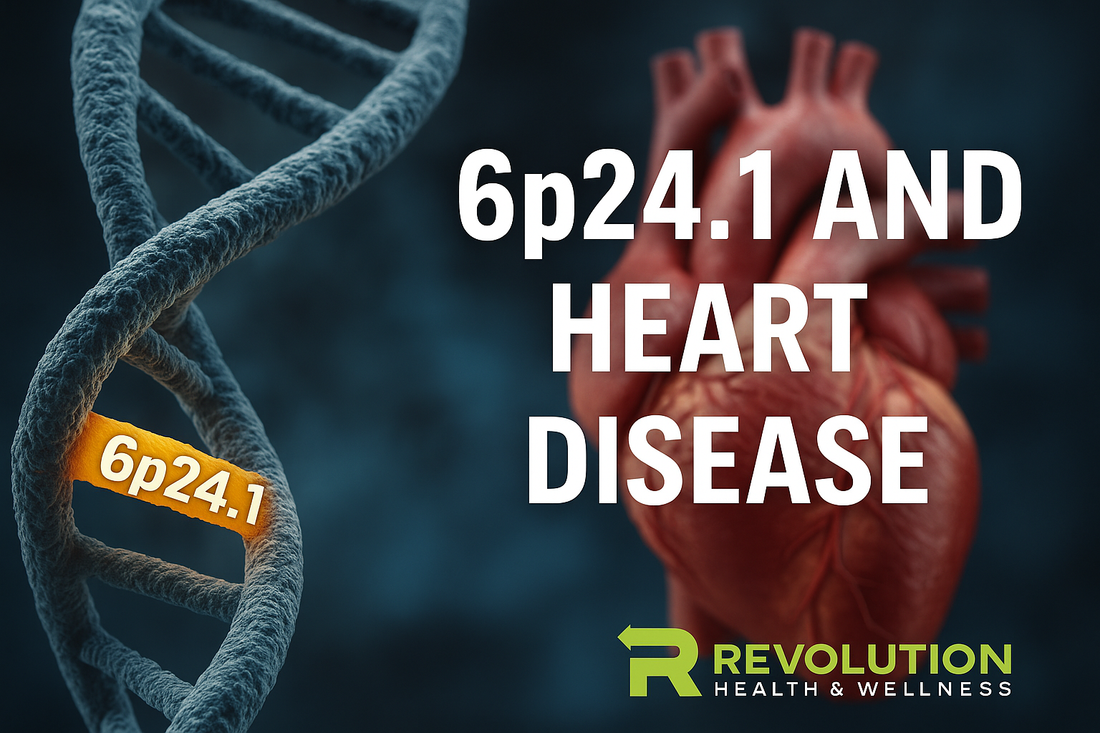PHACTR1 (6p24.1): From Genetic Risk to Heart-Protective Strategies
If you've ever wondered how your DNA influences your heart health—or why some people develop cardiovascular disease (CVD) despite a healthy lifestyle—one gene may offer insights: PHACTR1, located at chromosome 6p24.1.
Identified through genome-wide association studies (GWAS), the rs9349379 variant in PHACTR1 has emerged as a critical predictor of multiple vascular diseases, including coronary artery disease (CAD), fibromuscular dysplasia (FMD), spontaneous coronary artery dissection (SCAD), and hypertension. Often linked with altered vascular structure and endothelial dysfunction, understanding your PHACTR1 genotype empowers you to take meaningful, proactive steps to safeguard your arteries.
1. What Is PHACTR1?
Gene Basics
-
PHACTR1 stands for phosphatase and actin regulator 1, a gene on chromosome 6 at band p24.1, encoding a protein involved in actin cytoskeleton remodeling and interaction with protein phosphatase 1 (PP1).
-
It regulates cell shape, movement, and survival across diverse tissues—including endothelial and vascular smooth muscle cells.
2. Why PHACTR1 Matters for Heart Health
Genetic Associations
-
The rs9349379 variant, located within an intron of PHACTR1, has repeatedly been linked to CAD, myocardial infarction, migraine, SCAD, FMD, and hypertension.
-
Importantly:
-
rs9349379-G allele is associated with severe and multi-vessel CAD, especially in individuals ≤65 years old.
-
Other alleles may convey protection in familial hypercholesterolemia, reducing CAD risk by ~50%.
-
Vascular Biology and Pathophysiology
-
Cardiovascular Research (2023) showed that PHACTR1 influences arterial stiffness (aorta and carotid) but doesn't directly alter vasodilation capacity.
-
Another study confirms that elevated PHACTR1 expression—driven by inflammation (TNF-α, IL-1β) and oxidized LDL—promotes endothelial dysfunction by increasing ICAM1/VCAM1 and reducing nitric oxide production via Akt/eNOS pathways.
-
Loss of PHACTR1 in monocytes and endothelial cells contributes to atherosclerotic burden and impaired vascular repair.
3. PHACTR1 and Cardiovascular Risk: What Your DNA Might Reveal
| Genotype / Expression | Associated Risk |
|---|---|
| rs9349379-G variant | Increased risk of multi-vessel CAD, early CVD events |
| Reduced PHACTR1 expression | Atherosclerosis susceptibility, reduced endothelial resilience |
| Elevated PHACTR1 expression | Promotes endothelial inflammation and plaque vulnerability |
| Associations beyond CAD | Links to FMD, SCAD, migraine, hypertension |
4. How to Mitigate PHACTR1-Related Cardiovascular Risk
Even if your genes raise your risk, your choices make the difference. A landmark study found that healthy lifestyle changes can reduce early-onset coronary artery disease risk by up to 14-fold—even among individuals with high genetic risk scores.
Lifestyle Interventions
-
Adopt a heart-healthy diet: Rich in whole plants, lean proteins, omega-3 fatty acids, and minimal processed foods.
-
Engage in consistent exercise: Both aerobic (20–30 min, 4–5 times/week) and resistance training promote endothelial health and reduce stiffness.
-
Maintain healthy weight and metabolic markers: Manage blood pressure, lipids, and blood sugar.
-
Avoid smoking and reduce toxic exposures.
-
Manage stress and optimize sleep, both critical to vascular gene regulation.
Medical Monitoring & Interventions
-
Consider arterial stiffness assessments (e.g., pulse wave velocity) given PHACTR1’s structural role.
-
Regularly track lipid panels, inflammatory markers, and vascular imaging if warranted.
-
Discuss preventive statin therapy, which may be especially beneficial in genetic risk carriers.
Hormonal & Regenerative Support
-
Some investigational agents (e.g., statins) appear to lower PHACTR1 expression in endothelial models.
-
Pepetides and other regenerative therapies (e.g., for endothelial health) may be adjunct tools—especially as precision, patient-directed strategies evolve.
5. The Takeaway: Genes Are Not Destiny
PHACTR1 (6p24.1) is a verified genetic locus linked to cardiovascular pathology through endothelial inflammation, arterial stiffness, and impaired repair. Whether your risk is via a G variant, high expression, or early-onset disease, the good news is you’re not powerless.
By understanding the gene, you can empower your future. A combination of lifestyle optimization, vigilant monitoring, and tailored medical strategies can neutralize—and even reverse—much of the risk conferred by PHACTR1.
Call to Action
If you carry the PHACTR1 risk allele—or even if you’re just proactive about heart health—schedule a cardiovascular risk assessment with us. We’ll help you develop a DNA-informed, customized prevention plan that integrates diet, exercise, supplements, imaging, and medical therapy as needed.
References
-
Ma et al., PHACTR1 mediates endothelial dysfunction via inflammatory pathways—Frontiers (2022) (Oxford Academic, Frontiers)
-
Wood et al., PHACTR1 impacts vascular compliance across vessels—Cardiovascular Research (2023) (Oxford Academic)
-
Wikipedia, PHACTR1 gene function & associations (Wikipedia)
-
Kiando et al., PHACTR1 and FMD risk—PLOS Genetics (2016) (PLOS)
-
Lipids in Health and Disease (2024) on PHACTR1 G allele and multivessel CAD risk (BioMed Central)
-
Understanding gene-lifestyle risk modulation—Medical News Today (2024) (Medical News Today)


